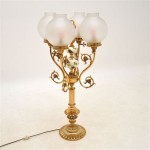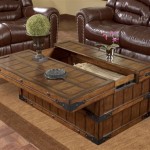Antique Coffee Table With Marble Top: A Timeless Blend of Elegance and History
The antique coffee table with a marble top represents a highly sought-after furniture piece, blending functionality with artistic expression and historical significance. These tables are not mere utilitarian objects; they are tangible links to past eras, embodying the craftsmanship, design sensibilities, and societal values of their time. Characterized by their exquisite marble surfaces and meticulously crafted bases, these tables offer a unique aesthetic appeal that complements various interior design styles.
The allure of antique marble-top coffee tables lies in their inherent beauty and durability. Marble, a metamorphic rock formed from crystallized limestone, has been prized for its luxurious appearance and resilience for centuries. Its cool, smooth surface provides an ideal platform for displaying decorative items, serving refreshments, or simply resting one's feet. Combined with the artistry of the table's base, which can be made of wood, metal, or even stone, these tables become captivating centerpieces in any living space.
Understanding the characteristics, historical context, and factors influencing the value of these tables is essential for collectors, enthusiasts, and individuals seeking to incorporate a touch of timeless elegance into their homes. This article will delve into the various aspects of antique coffee tables with marble tops, providing a comprehensive overview of their history, design, and significance in the world of antique furniture.
The Historical Evolution of Marble-Top Coffee Tables
The concept of the coffee table, as we know it today, evolved gradually over several centuries. While low tables existed in various forms throughout history, the specific purpose-built coffee table gained prominence in the late 19th and early 20th centuries. The rise in popularity of coffee consumption, particularly in Europe and North America, fueled the demand for a dedicated surface to place cups, books, and other items within easy reach while seated.
Marble, as a material for furniture tops, enjoyed a long history of usage in both functional and decorative contexts. From ancient Roman villas adorned with marble tables to Renaissance palaces featuring elaborate marble consoles, the stone symbolized wealth, refinement, and enduring elegance. The incorporation of marble into coffee tables, therefore, was a natural progression, combining the practicality of the table design with the luxurious appeal of the stone.
Early examples of antique coffee tables with marble tops often reflected the prevailing design aesthetics of their respective periods. Victorian-era tables, for instance, might showcase ornate wooden bases with intricate carvings, complemented by richly veined marble tops. Art Nouveau examples could feature flowing, organic forms in both the base and the marble itself, reflecting the movement's emphasis on natural motifs and curvilinear lines. The early 20th century saw the emergence of Art Deco styles, characterized by geometric patterns, streamlined shapes, and the use of contrasting materials, often seen in marble-top tables with metal bases and bold, graphic marble veining.
During these periods, marble was sourced from various locations, each characterized by distinct colors and veining patterns. Italian marble, particularly Carrara marble with its pristine white background and subtle gray veining, was highly prized for its quality and beauty. Other notable marble sources included France, Belgium, and Greece, each offering a range of colors and patterns that added to the diversity of marble-top coffee table designs. The choice of marble often reflected the aesthetic preferences of the period and the intended style of the table.
The historical evolution of marble-top coffee tables demonstrates a continuous interplay between design trends, material availability, and the evolving social customs surrounding coffee consumption and interior decor. These tables serve as valuable artifacts, providing insights into the artistic and cultural expressions of different eras.
Identifying Key Design Elements and Construction Techniques
Identifying and analyzing the key design elements and construction techniques used in antique coffee tables with marble tops is crucial for determining their age, origin, and authenticity. Several factors contribute to the overall aesthetic and structural integrity of these tables.
The
base material and construction
play a significant role in defining the table's style and period. Wooden bases, commonly crafted from hardwoods like mahogany, walnut, or oak, often exhibit intricate carvings, turned legs, or cabriole feet depending on the prevailing design trends. Metal bases, typically made of wrought iron, brass, or bronze, can range from simple, minimalist designs to elaborate, sculptural forms. The method of joining the base components, whether through mortise and tenon joints, dovetail joints, or welding, can also provide clues about the table's age and craftsmanship.The
marble top itself
is a defining feature, and its characteristics can reveal information about its origin and quality. Identifying the type of marble, based on its color, veining, and texture, is an important step. Carrara, Calacatta, Verde Antique, and Breccia are just a few examples of the many varieties of marble used in furniture making. Examining the surface finish and any signs of wear or damage, such as scratches, stains, or chips, can also provide valuable insights into the table's history and use.The
method of attaching the marble top to the base
varries. Sometimes the marble rests purely on top of the base and uses its weight to remain in place. Other tables might use screws or other fixings to keep the top still and stable. The methods used can hint at its origin and age.Other design elements to consider include the table's overall shape and dimensions, the presence of any decorative details such as inlays, gilding, or bronze mounts, and the style of hardware used for drawers or other functional components. Analyzing these details in conjunction with historical design references can help to accurately date and authenticate the table.
Furthermore, understanding the common construction techniques employed during different periods is essential. For example, hand-cut dovetails are characteristic of earlier periods, while machine-cut dovetails are indicative of later production. Similarly, the types of glues and finishes used can provide clues about the table's age and origin. Skilled craftsmanship and attention to detail are hallmarks of genuine antique pieces.
Assessing Value and Condition Considerations
The value of an antique coffee table with a marble top is determined by a combination of factors, including its age, rarity, design quality, condition, and provenance. Assessing these factors requires a keen eye and a thorough understanding of the antique furniture market.
Age and Rarity:
Older and rarer tables generally command higher prices. Tables from specific periods or movements, such as the Victorian era or the Art Deco period, often hold significant value due to their historical significance and aesthetic appeal. Tables with unique or unusual designs are also highly sought after by collectors.Design Quality:
The quality of the design and execution plays a crucial role in determining value. Tables with exceptional craftsmanship, intricate carvings, or unique material combinations tend to be more valuable. The aesthetic appeal and overall balance of the design also contribute to its desirability.Condition:
The condition of the table is a significant factor affecting its value. Tables in excellent condition, with minimal wear and tear, are generally more valuable than those with significant damage or repairs. However, some degree of wear is expected in antique furniture, and minor imperfections can even add to its character and authenticity.Provenance:
The provenance, or history of ownership, of a table can also influence its value. Tables with documented ownership by notable individuals or institutions often command higher prices. Evidence of provenance, such as original receipts, labels, or photographs, can significantly enhance the table's desirability.When assessing the condition of an antique coffee table with a marble top, it is important to carefully inspect the marble surface for any cracks, chips, stains, or repairs. The base should also be examined for structural integrity, signs of woodworm, or any previous repairs. Restorations, if professionally done, can enhance the value of the table, but poorly executed repairs can detract from its appeal.
It is recommended to consult with experienced antique appraisers or furniture specialists to obtain an accurate assessment of the table's value and condition. These experts can provide valuable insights into the table's history, design, and authenticity, helping to inform purchasing or selling decisions.
Overall, antique coffee tables with marble tops represent a captivating intersection of art, history, and functionality. They continue to captivate collectors and enthusiasts with their timeless elegance and enduring appeal, making them treasured additions to any home or collection.

Antique Marble Top Coffee Table Ta 016 Dahlia Vintage

Antique French Marble Top Coffee Table At 1stdibs Old

Antique Oval Marble Top Coffee Table Collection Victorian Walnut With Italian Coff Coffe Decor

Vintage Coffee Table With Marble Top And Carved Legs For Sale At Pamono

Vintage Italian Rococo Marble Top Coffee Table Item 1076186

Antique Coffee Table In Walnut With Marble Top By Metge 1890s For Sale At Pamono

Antique French Louis Xv Marble Top Painted Coffee Table

Antique Italian Coffee Tea Table With Marble Top

Vintage Mid Century Modern Round Marble Top Gilt Base Coffee Table 695

French Louis Xv Style Gilt Wood Marble Top Coffee Table Moonee Ponds Antiques








